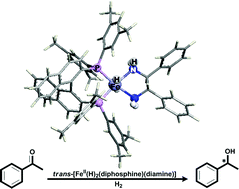trans-FeII(H)2(diphosphine)(diamine) complexes as alternative catalysts for the asymmetric hydrogenation of ketones? A DFT study†
Abstract
New insights into the structural, electronic and ![[partial double bond, bottom dashed]](https://www.rsc.org/images/entities/char_e00f.gif) N
N

a
Kathleen Lonsdale Building, Department of Chemistry, University College London, Gower Street, London, United Kingdom
E-mail:
c.r.a.catlow@ucl.ac.uk
b Department of Chemistry, Christopher Ingold Laboratories, University College London, 20 Gordon Street, London, United Kingdom
New insights into the structural, electronic and ![[partial double bond, bottom dashed]](https://www.rsc.org/images/entities/char_e00f.gif) N
N

 Please wait while we load your content...
Something went wrong. Try again?
Please wait while we load your content...
Something went wrong. Try again?
H. T. Chen, D. Di Tommaso, G. Hogarth and C. R. A. Catlow, Dalton Trans., 2011, 40, 402 DOI: 10.1039/C0DT00820F
To request permission to reproduce material from this article, please go to the Copyright Clearance Center request page.
If you are an author contributing to an RSC publication, you do not need to request permission provided correct acknowledgement is given.
If you are the author of this article, you do not need to request permission to reproduce figures and diagrams provided correct acknowledgement is given. If you want to reproduce the whole article in a third-party publication (excluding your thesis/dissertation for which permission is not required) please go to the Copyright Clearance Center request page.
Read more about how to correctly acknowledge RSC content.
 Fetching data from CrossRef.
Fetching data from CrossRef.
This may take some time to load.
Loading related content
